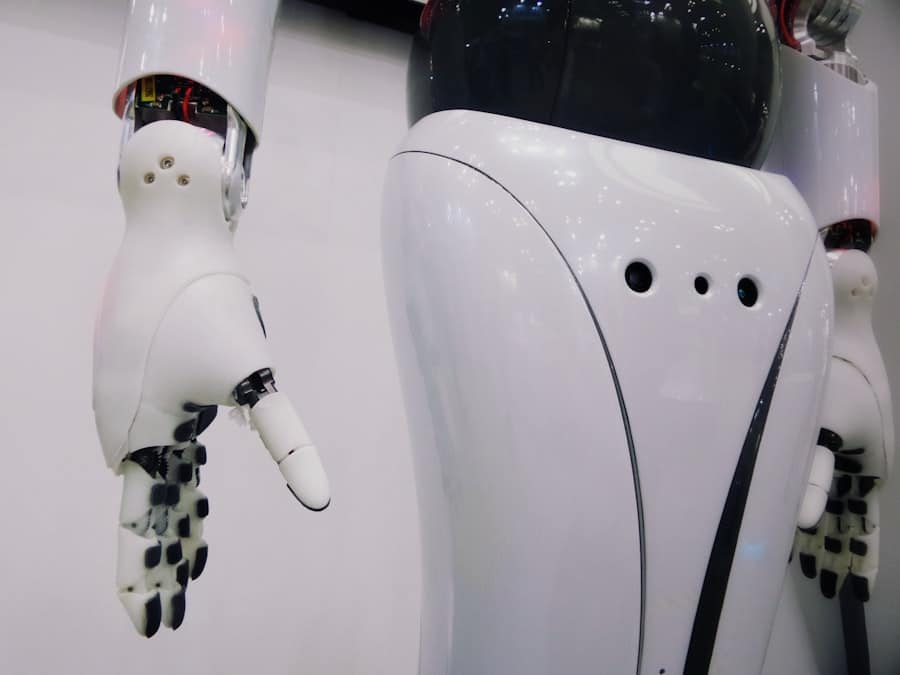The integration of artificial intelligence (AI) and robotics into the field of surgery represents a transformative shift in how surgical procedures are conceived, planned, and executed. Over the past few decades, advancements in technology have paved the way for innovative tools that enhance the capabilities of surgeons, improve patient outcomes, and streamline surgical workflows. AI, characterized by its ability to analyze vast amounts of data and learn from patterns, complements robotic systems that offer precision and dexterity beyond human capabilities.
This synergy is not merely a trend; it is a fundamental evolution in surgical practice that promises to redefine the landscape of healthcare. As surgical techniques evolve, the demand for enhanced accuracy and efficiency has never been greater. Traditional surgical methods, while effective, often come with limitations such as longer recovery times, increased risk of complications, and variability in outcomes based on the surgeon’s skill level.
The advent of AI and robotics addresses these challenges head-on. By harnessing machine learning algorithms and robotic-assisted technologies, surgeons can now perform complex procedures with greater confidence and reduced invasiveness. This article delves into the multifaceted roles of AI and robotics in surgery, exploring their applications from preoperative planning to postoperative care.
Key Takeaways
- AI enhances preoperative planning and surgical decision-making for better outcomes.
- Robotics enable minimally invasive surgeries with increased precision and reduced recovery time.
- AI and robotic systems assist intraoperatively to improve accuracy and reduce human error.
- Postoperative care benefits from AI-driven monitoring and personalized recovery plans.
- Ethical challenges and limitations must be addressed to fully realize the future potential of AI and robotics in surgery.
The Role of AI in Preoperative Planning and Decision Making
Preoperative planning is a critical phase in the surgical process, where decisions made can significantly influence patient outcomes. AI plays a pivotal role in this stage by providing data-driven insights that enhance decision-making. Machine learning algorithms can analyze patient data, including medical history, imaging studies, and genetic information, to identify potential risks and recommend optimal surgical approaches.
Moreover, AI can assist in creating personalized surgical plans tailored to individual patients. By utilizing predictive analytics, AI can forecast potential complications based on a patient’s unique profile.
This capability enables surgeons to prepare for contingencies and select the most appropriate techniques or interventions. For example, in orthopedic surgery, AI can help determine the best implant size and positioning by analyzing preoperative imaging data alongside historical outcomes from similar cases. This level of precision not only enhances surgical efficacy but also contributes to improved patient safety.
The Use of Robotics in Minimally Invasive Surgeries

Minimally invasive surgery (MIS) has revolutionized the way many procedures are performed, offering patients reduced pain, shorter recovery times, and minimal scarring compared to traditional open surgeries. Robotic systems have become integral to this paradigm shift, providing surgeons with enhanced visualization and dexterity during operations. Robotic-assisted platforms, such as the da Vinci Surgical System, allow for precise manipulation of instruments through small incisions, translating the surgeon’s hand movements into highly accurate actions within the surgical field.
The advantages of robotic systems extend beyond mere precision; they also facilitate complex maneuvers that would be challenging or impossible with conventional techniques. For instance, in urological surgeries like prostatectomies, robotic assistance enables surgeons to navigate intricate anatomical structures with unparalleled control. The three-dimensional visualization provided by robotic cameras enhances depth perception, allowing for meticulous dissection and suturing.
As a result, patients experience less trauma to surrounding tissues and a quicker return to normal activities.
AI and Robotics in Intraoperative Assistance and Precision
During surgery, the combination of AI and robotics offers real-time assistance that significantly enhances intraoperative precision. Robotic systems equipped with AI capabilities can analyze data from various sources—such as imaging modalities and patient vitals—while the procedure is underway. This integration allows for dynamic adjustments based on the evolving surgical environment.
For example, if unexpected bleeding occurs during a procedure, AI algorithms can quickly assess the situation and suggest immediate interventions or adjustments to the surgical plan. Furthermore, AI-driven robotic systems can assist in maintaining optimal conditions throughout the operation. They can monitor vital signs and other parameters continuously, alerting the surgical team to any deviations from expected norms.
This proactive approach not only enhances patient safety but also allows surgeons to focus on executing complex tasks without being distracted by manual monitoring. The result is a more streamlined surgical experience where precision is paramount.
Advancements in Postoperative Care and Recovery with AI and Robotics
| Metric | Traditional Surgery | AI & Robotics Assisted Surgery | Improvement |
|---|---|---|---|
| Average Surgery Duration | 120 minutes | 90 minutes | 25% reduction |
| Precision of Incisions | ±2 mm | ±0.2 mm | 10x improvement |
| Patient Recovery Time | 14 days | 7 days | 50% faster |
| Complication Rate | 15% | 5% | 66% reduction |
| Surgeon Fatigue | High | Low (due to robotic assistance) | Significant reduction |
| Real-time Data Analysis | Limited | Advanced AI-driven analytics | Enhanced decision-making |
| Cost Efficiency | Baseline | Improved long-term due to fewer complications | Cost savings over time |
The role of AI and robotics extends beyond the operating room into postoperative care and recovery. Advanced monitoring systems powered by AI can track patient recovery metrics in real-time, providing healthcare providers with valuable insights into a patient’s progress. For instance, wearable devices equipped with sensors can collect data on vital signs, mobility levels, and pain scores post-surgery.
This information is then analyzed by AI algorithms to identify trends or potential complications early on. In addition to monitoring, robotic systems are being developed to assist with rehabilitation following surgery. Robotic exoskeletons and rehabilitation robots can aid patients in regaining mobility and strength after procedures such as joint replacements or spinal surgeries.
These devices provide targeted support and feedback during physical therapy sessions, enhancing recovery outcomes by ensuring that patients adhere to prescribed rehabilitation protocols. The combination of AI analytics and robotic assistance creates a comprehensive approach to postoperative care that prioritizes patient well-being.
Challenges and Limitations of AI and Robotics in Surgery

Despite the promising advancements brought about by AI and robotics in surgery, several challenges and limitations persist that warrant careful consideration. One significant concern is the high cost associated with implementing robotic systems in surgical practice. The initial investment required for purchasing robotic platforms, along with ongoing maintenance and training costs for surgical teams, can be prohibitive for many healthcare institutions.
This financial barrier may limit access to advanced surgical technologies in certain regions or healthcare settings. Additionally, there are concerns regarding the reliability of AI algorithms in clinical decision-making. While machine learning models can analyze vast datasets effectively, they are not infallible.
The potential for algorithmic bias—where certain demographic groups may be underrepresented in training datasets—can lead to disparities in care outcomes. Furthermore, reliance on technology raises questions about the erosion of traditional surgical skills among practitioners who may become overly dependent on robotic assistance. Balancing technological innovation with the preservation of essential surgical competencies remains a critical challenge.
Ethical Considerations and Future Implications of AI and Robotics in Surgery
The integration of AI and robotics into surgery raises important ethical considerations that must be addressed as these technologies continue to evolve. One primary concern revolves around patient autonomy and informed consent. As AI systems become more involved in decision-making processes, ensuring that patients understand how these technologies influence their care becomes paramount.
Surgeons must communicate clearly about the role of AI in their treatment plans while respecting patients’ rights to make informed choices about their healthcare. Moreover, issues related to accountability arise when complications occur during robotic-assisted surgeries. Determining liability—whether it lies with the surgeon, the technology provider, or the institution—can be complex in cases where AI algorithms influence clinical decisions.
Establishing clear guidelines for accountability will be essential as reliance on these technologies increases. Additionally, ongoing education for healthcare professionals about ethical implications will be crucial as they navigate the intersection of technology and patient care.
The Future of Next-Gen Surgeries with AI and Robotics
The future of surgery is poised for remarkable transformation through the continued integration of AI and robotics. As these technologies advance further, we can anticipate even greater enhancements in surgical precision, efficiency, and patient outcomes. The potential for personalized medicine will expand as AI algorithms become more sophisticated at analyzing individual patient data to inform tailored treatment plans.
Moreover, as robotic systems become more accessible and cost-effective, their adoption across diverse healthcare settings will likely increase. This democratization of advanced surgical technologies has the potential to improve care quality globally while addressing disparities in access to cutting-edge treatments. As we look ahead, it is clear that the collaboration between human expertise and technological innovation will shape the next generation of surgical practices—ultimately leading to safer surgeries and improved patient experiences across the board.
In the realm of medical technology, the integration of AI and robotics is revolutionizing surgical procedures, enhancing precision and patient outcomes. For those interested in exploring how technology is shaping various industries, a related article on the latest advancements in wearable technology can be found in the piece about the top smartwatches of 2023. This article highlights how smart devices are not only improving personal health monitoring but also paving the way for innovations in medical applications.
FAQs
What role does AI play in next-generation surgeries?
AI assists in next-generation surgeries by enhancing precision, enabling real-time data analysis, improving diagnostic accuracy, and supporting decision-making during procedures. It helps in planning surgeries, predicting outcomes, and personalizing treatment for patients.
How are robotics integrated into surgical procedures?
Robotics are integrated into surgical procedures through robotic-assisted systems that allow surgeons to perform minimally invasive operations with greater dexterity, control, and accuracy. These systems often include robotic arms, advanced imaging, and haptic feedback to improve surgical outcomes.
What are the benefits of combining AI and robotics in surgery?
Combining AI and robotics in surgery leads to improved precision, reduced human error, shorter recovery times, less invasive procedures, and enhanced patient safety. It also enables complex surgeries to be performed with higher success rates and better postoperative results.
Are AI and robotic surgeries widely available in hospitals today?
AI and robotic surgeries are increasingly available in many advanced medical centers worldwide, but their availability depends on the hospital’s resources, infrastructure, and expertise. While adoption is growing, some regions may have limited access due to cost and training requirements.
Do AI and robotic systems replace surgeons?
No, AI and robotic systems do not replace surgeons. Instead, they serve as tools that augment the surgeon’s capabilities, providing enhanced precision and support. Surgeons remain in control and make critical decisions throughout the procedure.
What types of surgeries benefit most from AI and robotics?
Surgeries that benefit most include minimally invasive procedures such as laparoscopic surgery, neurosurgery, cardiac surgery, orthopedic surgery, and certain types of cancer surgeries. These technologies help improve accuracy and reduce complications in complex operations.
Is patient data used in AI-driven surgical systems?
Yes, patient data such as medical history, imaging, and real-time monitoring are used by AI-driven systems to tailor surgical plans and provide personalized care. Data privacy and security are critical considerations in the use of such technologies.
What challenges exist in implementing AI and robotics in surgery?
Challenges include high costs, the need for specialized training, regulatory approvals, integration with existing hospital systems, and ensuring patient safety. Ethical considerations and data privacy also play important roles in the adoption of these technologies.
How do AI and robotics improve surgical training?
AI and robotics improve surgical training by providing simulation environments, real-time feedback, and performance analytics. Trainees can practice complex procedures in a controlled setting, enhancing their skills before performing on actual patients.
What is the future outlook for AI and robotics in surgery?
The future outlook is promising, with ongoing advancements expected to make surgeries safer, more efficient, and more accessible. Innovations such as autonomous robotic systems, enhanced AI diagnostics, and improved human-machine interfaces are anticipated to further transform surgical care.

